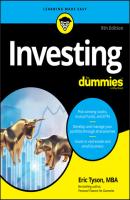Investing For Dummies. Eric Tyson
Чтение книги онлайн.

Читать онлайн книгу Investing For Dummies - Eric Tyson страница 30
Название: Investing For Dummies
Автор: Eric Tyson
Издательство: John Wiley & Sons Limited
Жанр: Личные финансы
isbn: 9781119716518
isbn:
Opt for tax-free money markets and bonds. If you’re in a high enough tax bracket, you may find that you come out ahead with tax-free investments. Tax-free investments yield less than comparable investments that produce taxable earnings, but because of the tax differences, the earnings from tax-free investments can end up being greater than what taxable investments leave you with. In order to compare properly, subtract what you’ll pay in federal as well as state taxes from the taxable investment to see which investment nets you more.
Invest in tax-friendly stock funds. Mutual and exchange-traded funds that tend to trade less tend to produce lower capital gains distributions. For funds held outside tax-sheltered retirement accounts, this reduced trading effectively increases an investor’s total rate of return. Index funds invest in a relatively static portfolio of securities, such as stocks and bonds (this is also true of some exchange-traded funds). They don’t attempt to beat the market. Rather, they invest in the securities to mirror or match the performance of an underlying index, such as the Standard & Poor’s 500 (which I discuss in Chapter 5). Although index funds can’t beat the market, the typical actively managed fund doesn’t, either, and index funds have several advantages over actively managed funds. See Chapter 8 to find out more about tax-friendly stock mutual funds, which includes some non-index funds, and exchange-traded funds.
Invest in small business and real estate. The growth in value of business and real estate assets isn’t taxed until you sell the asset. Even then, with investment real estate, you often can rollover the gain into another property as long as you comply with tax laws. However, the current income that small business and real estate assets produce is taxed as ordinary income.
Choosing the Right Investment Mix
Diversifying your investments helps buffer your portfolio from being sunk by one or two poor performers. In the following sections, I explain how to mix up a great recipe of investments.
Considering your age
When you’re younger and have more years until you plan to use your money, you should keep larger amounts of your long-term investment money in growth (ownership) vehicles, such as stocks, real estate, and small business. As I discuss in Chapter 2, the attraction of these types of investments is the potential to really grow your money. The risk: The value of your portfolio can fall from time to time.
The younger you are, the more time your investments have to recover from a bad fall. In this respect, investments are a bit like people. If a 30-year-old and an 80-year-old both fall on a concrete sidewalk, odds are higher that the younger person will fully recover and the older person may not. Such falls sometimes disable older people.
If you want to be more aggressive, subtract your age from 120:
Note that even retired people should still have a healthy chunk of their investment dollars in growth vehicles like stocks. A 70-year-old person may want to totally avoid risk, but doing so is generally a mistake. Such a person can live another two or three decades. If you live longer than anticipated, you can run out of money if it doesn’t continue to grow.
Making the most of your investment options
No hard-and-fast rules dictate how to allocate the percentage that you’ve earmarked for growth among specific investments like stocks and real estate. Part of how you decide to allocate your investments depends on the types of investments that you want to focus on. As I discuss in Chapter 5, diversifying in stocks worldwide can be prudent as well as profitable.
Here are some general guidelines to keep in mind:
Take advantage of your retirement accounts. Unless you need accessible money for shorter-term non-retirement goals, why pass up the free extra returns from the tax benefits of retirement accounts?
Don’t pile your money into investments that have gained lots of attention. Many investors make this mistake, especially those who lack a thought-out plan to buy stocks. In Chapter 5, I provide numerous illustrations of the perils of buying attention-grabbing stocks.
Have the courage to be a contrarian. No one likes to feel that he is jumping on board a sinking ship or supporting a losing cause. However, just as in shopping for something at retail stores, the best time to buy something of quality is when its price is reduced.
Diversify. As I discuss in Chapter 2, the values of different investments don’t move in tandem. So when you invest in growth investments, such as stocks or real estate, your portfolio’s value will have a smoother ride if you diversify properly.
Invest more in what you know. Over the years, I’ve met successful investors who have built substantial wealth without spending gobs of their free time researching, selecting, and monitoring investments. For example, some investors concentrate more on real estate because that’s what they best understand and feel comfortable with. Others put more money in stocks for the same reason. No one-size-fits-all code exists for successful investors. Just be careful that you don’t put all your investing eggs in the same basket (for example, don’t load up on stocks in the same industry that you believe you know a lot about).
Don’t СКАЧАТЬ